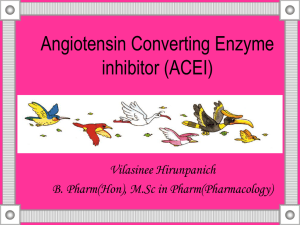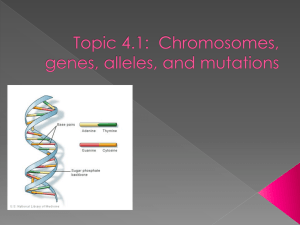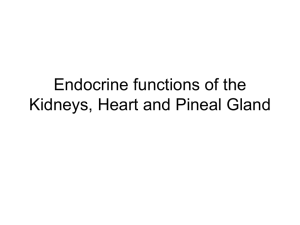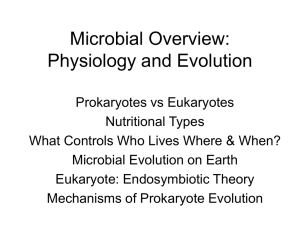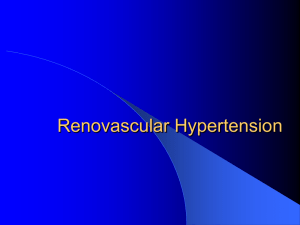Dominant Renin Gene Mutation Clinical and Molecular
advertisement
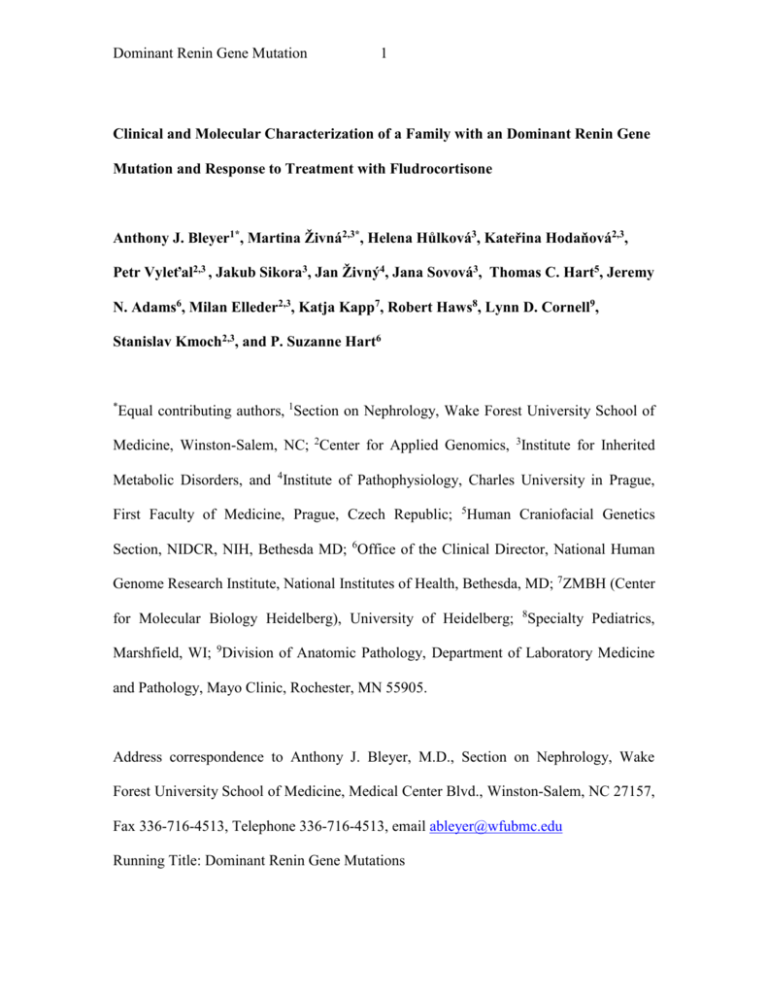
Dominant Renin Gene Mutation 1 Clinical and Molecular Characterization of a Family with an Dominant Renin Gene Mutation and Response to Treatment with Fludrocortisone Anthony J. Bleyer1*, Martina Živná2,3*, Helena Hůlková3, Kateřina Hodaňová2,3, Petr Vyleťal2,3 , Jakub Sikora3, Jan Živný4, Jana Sovová3, Thomas C. Hart5, Jeremy N. Adams6, Milan Elleder2,3, Katja Kapp7, Robert Haws8, Lynn D. Cornell9, Stanislav Kmoch2,3, and P. Suzanne Hart6 * Equal contributing authors, 1Section on Nephrology, Wake Forest University School of Medicine, Winston-Salem, NC; 2Center for Applied Genomics, 3Institute for Inherited Metabolic Disorders, and 4Institute of Pathophysiology, Charles University in Prague, First Faculty of Medicine, Prague, Czech Republic; 5Human Craniofacial Genetics Section, NIDCR, NIH, Bethesda MD; 6Office of the Clinical Director, National Human Genome Research Institute, National Institutes of Health, Bethesda, MD; 7ZMBH (Center for Molecular Biology Heidelberg), University of Heidelberg; 8Specialty Pediatrics, Marshfield, WI; 9Division of Anatomic Pathology, Department of Laboratory Medicine and Pathology, Mayo Clinic, Rochester, MN 55905. Address correspondence to Anthony J. Bleyer, M.D., Section on Nephrology, Wake Forest University School of Medicine, Medical Center Blvd., Winston-Salem, NC 27157, Fax 336-716-4513, Telephone 336-716-4513, email ableyer@wfubmc.edu Running Title: Dominant Renin Gene Mutations Dominant Renin Gene Mutation 2 Abstract: A family was identified with autosomal dominant inheritance of anemia, polyuria, hyperuricemia, and chronic kidney disease. Mutational analysis revealed a novel heterozygous mutation c.58T>C resulting in the amino acid substitution of cysteine for arginine in the preprorenin signal sequence (p.Cys20Arg) occurring in all affected members. Methods: Effects of the identified mutation were characterized using in vitro and in vivo studies. Affected individuals were clinically characterized before and after administration of fludrocortisone. Results: The mutation affects endoplasmic reticulum cotranslational translocation and posttranslational processing, resulting in massive accumulation of non-glycosylated preprorenin in the cytoplasm. This affects expression of intra-renal RAS components and leads to ultrastructural damage of the kidney. Affected individuals suffered from anemia, hyperuricemia, decreased urinary concentrating ability, and progressive chronic kidney disease. Treatment with fludrocortisone in an affected 10 year old child resulted in an increase in blood pressure and estimated glomerular filtration rate. Conclusions: A novel REN gene mutation resulted in an alteration in the amino acid sequence of the renin signal sequence and caused childhood anemia, polyuria, and kidney disease. Treatment with fludrocortisone improved renal function in an affected child. Nephrologists should consider REN mutational analysis in families with autosomal dominant inheritance of chronic kidney disease, especially if they suffer from anemia, hyperuricemia, and polyuria in childhood. Dominant Renin Gene Mutation 3 Key words: anemia, children, fludrocortisone, hyperuricemia, renin mutation Introduction: Autosomal dominant interstitial kidney disease associated with hyperuricemia has previously been attributed to mutations in the UMOD gene[3], which produces uromodulin. Recently a mutation in the gene encoding renin was identified as a cause of hereditary interstitial kidney disease associated with hyperuricemia[11]. In this investigation, we describe a family with a novel REN mutation affecting the preprorenin signal sequence and resulting in an autosomal dominant clinical syndrome characterized by decreased plasma renin levels, polyuria, anemia, hyperuricemia, and progressive kidney failure. We describe how the mutation modifies the biosynthesis of the renin preproprotein, the effects of the mutation at the cellular level, and the pathophysiologic changes that result from the mutation. For the first time we describe treatment of this condition with fludrocortisone. Methods: The procedures were approved by the Wake Forest University School of Medicine Institutional Review Board. Patient ascertainment: The family was referred by RH for evaluation of anemia, polyuria, and chronic kidney disease. Blood and urine samples were obtained for chemical and genetic analysis, and a retrospective review of medical records was performed. DNA samples were collected on family members, and mutational analysis of the REN gene was performed. In affected individuals, 24 hour urine collections were performed on an ad libitum diet for urinary electrolytes and aldosterone. Random plasma renin and aldosterone levels Dominant Renin Gene Mutation 4 were determined. When one of the patients (AIII2 - see Figure 1A) was identified as having hypoaldosteronism, the patient's nephrologist started her on fludrocortisone acetate, 0.1 mg orally each day. Two other affected individuals (AII6 and an unrelated individual with a heterozygous deletion p.Leu16del in the REN gene characterized in our previous study (BII2 [11]) were enrolled in a protocol in which baseline blood and urine samples were obtained, and participants were then placed on 3 days of fludrocortisone at a dosage of 0.1 mg orally each day, followed by fludrocortisone at a dosage of 0.2 mg orally for 4 days. Sequence analysis and genotyping: The REN gene was PCR amplified from genomic DNA and sequenced in AII6, AIII2, and clinically unaffected family members using methods previously described [11]. The presence of a novel REN mutation was evaluated in the complete family and in a control European American population (n=385) by direct sequencing. A set of microsatellite markers flanking the REN locus were genotyped to identify the disease associated haplotype segregating with the novel REN mutation. Laboratory investigation: In silico analysis: Preprorenin signal sequences from the presented species were obtained from the UniProtKB/Swiss-Prot database. Multiple alignment and evaluation for amino acid conservation were performed by ClustalW2 software (http://www.ebi.ac.uk/Tools/clustalw2/). Properties of the signal sequences were assessed using the SignalP 3.0 server[1]and the Kyte and Doolittle method[6]. Dominant Renin Gene Mutation 5 In vitro translation/ translocation and transient expression of the p.Cys20Arg preprorenin: Construction of the wild-type preprorenin (WTREN) eukaryotic expression vector was performed as previously described[11]. The mutant construct c.58T>C, encoding the p.Cys20Arg preprorenin (C20RREN), was prepared by site directed mutagenesis of the WTREN vector using a mutation specific oligonucleotide primer and the GeneTailorTM Site – Directed Mutagenesis System Kit (Invitrogen, Paisley, UK). In vitro translation/ translocation assays, transient transfection of human embryonic kidney (HEK293) cells, culturing conditions, cell lysate preparation, media collection, and Western blot and immunofluorescence analyses of prorenin and renin were carried out as previously described[11]. Renin granulosity was assessed by the fluorescence-activated cell sorter (FACS) assay, measuring the differences in the fluorescence intensity and the number of granular cells after the transient transfection of HEK293 cells with WTREN, C20RREN and empty pCR3.1 expression vectors and labeling of low-pH secretory granules with fluorescent aminoacridine dye quinacrine. For this assay, 8 x 105 HEK293 cells were transfected with 4 µg of the corresponding vectors. Cells were mechanically harvested 24 hours posttransfection using 1.2 mL of supplemented Dulbecco's Modified Eagle's Medium (DMEM) without phenol red. Five minutes before the analysis, 400 µl of 8 µM quinacrine dihydrochloride (Sigma, Prague, Czech Republic) in DMEM without phenol red was added to 400 µl of the cell suspension containing aproximately 500,000 cells. Fluorescence was measured using FACS Calibur flow cytometer, and data were analyzed using Cell Quest software version 3.3. (Becton Dickinson, San Jose, Ca, USA). Granular cells were counted in gated side scatter high population. The number of low-pH granules Dominant Renin Gene Mutation 6 was quantified as the mean fluorescence intensity (MFI) of gated quinacrine positive population of 100,000 cells. Light microscopy, immunohistochemistry and electronmicroscopy studies: A kidney biopsy of patient AII6 was performed; the tissue sample was processed as previously described[5]. Selected antigens were investigated using the following primary antibodies: prorenin + renin - Rabbit Anti-Preprorenin (amino acid residues 288-317), (Yanaihara, Shizuoka, Japan); angiotensin converting enzyme 1, mouse anti-angiotensin converting enzyme 1 antibody (Abcam, Cambridge, UK); angiotensin II, mouse antiangiotensin II antibody (Acris, Herford, Germany); uromodulin, rabbit anti-TammHorsfall protein antibody (Biogenesis, Poole, UK). Ultrastructural studies were performed on deparaffinized tissue from the material originally submitted for light microscopy. Thin sections were double contrasted with uranyl acetate and lead nitrate and examined using Jeol 1200 EX electron microscope. Results: Clinical Findings: Patient AIII2: The proband was the product of a 38 week gestation and weighed 3.19 kg at birth. She presented with acute kidney failure at 3 years. The patient had suffered from a viral syndrome with fevers up to 38.9 oC and was placed on non-steroidal anti-inflammatory agents (NSAIDs). Laboratory studies revealed a blood urea nitrogen (BUN) of 25.3 mmol/L (71 mg/dl) (normal range 1.8-6.4 mmol/L), serum creatinine 124 umol/L (1.4 mg/dl) (normal 37.2-50.4 umol/L), and hemoglobin 76 g/L (normal 115-135 g/L). Acute kidney failure was attributed to NSAIDs, which were stopped with a decline in the serum creatinine to 71 umol/L (0.8 mg/dl). The patient was evaluated at age 6 years Dominant Renin Gene Mutation 7 for a persistently elevated serum creatinine level of 106 umol/L (1.2 mg/dl). The patient was asymptomatic except for nocturia. On physical examination the patient appeared her stated age, with height 118.5 cm and weight 22.7 kg. The blood pressure was 82/52 mm Hg with pulse 86 beats per minute. The rest of the physical examination was unremarkable. With renal ultrasound, the right kidney was 7 cm and the left kidney 8.5 cm (normal for age 8.5-11.5 cm) without any cysts. A computerized axial tomographic scan revealed no cysts. The serum sodium was 141 mmol/L, potassium 5.5 mmol/L, chloride 106 mmol/L, bicarbonate 23 mmol/L, BUN 19.6 mmol/L, and serum creatinine 106.1 mmol/L. The serum uric acid was elevated at 375 mmol/L (6.3 mg/dl) (normal range 107-315 mmol/L), with a fractional excretion of uric acid (FEurate) 5.2% (normal 6-20%). A 24 hour urine collection revealed 6.3 mg/m2/hour protein (normal < 4 mg/m2/hour), urine sodium 5.2 mEq/kg/day, and volume 57 ml/kg. The creatinine clearance was 58 ml/min/1.73 m2. The hemoglobin level was low at 105 g/L, with an iron saturation of 5%, ferritin 135 ng/ml, and erythropoietin level 3.2 mIU/ml (normal 4-21 mIU/ml). Clinical course: Anemia: The patient was started on iron replacement and darbepoeitin alfa. At age 7 the iron saturation was 33% and ferritin 541 ng/ml, but the patient has subsequently remained dependent on darbepoeitin alfa therapy to maintain hemoglobin levels above 11 g/dl to the present age of 11 years. Hyperuricemia: The patient's serum uric acid remained elevated, rising to 458 mmol/L (7.7 mg/dl) at age 7. The FEurate remained low with readings less than 5.2%, and the lowest reading of 3.2%. Dominant Renin Gene Mutation 8 Renin/aldosterone: A random plasma renin activity was <0.5 ng/ml/h (normal 0.55.9 ng/ml/hr) with a random serum aldosterone measurement <4.0 ng/dl at age 10 years (normal 4-31 ng/dl). A 24 hour urine aldosterone was 2 μg/24 hours (normal 2-16 μg). Treatment with fludrocortisone: Based on the findings of hyporeninemic hypoaldosteronism, the patient was started on treatment with fludrocortisone, 0.1 mg orally each day at age 10 years. The eGFR showed a significant increase with administration of fludrocortisone (see Figure 2), which was sustained (Table 1). Urinary concentration. Overnight urinary osmolality (with fasting from 10 pm to 8 am), was 386 mOsm/kg while receiving fludrocortisone. Two hours later, with continued fasting, the urine osmolality was 377 mOsm/kg. A repeat measurement was performed 4 months after fludrocortisone therapy. At that time the overnight urine osmolality remained at 386 mOsm/kg. Patient AII6: The proband's father presented at age 14 years for unexplained anemia with a hemoglobin 93 g/L, white blood count 5000/ml, and platelet count 101,000/ml. Bone marrow aspirate revealed normoblastic hypoplasia. The patient was diagnosed with hypoplasia of the bone marrow, cause unknown. As part of the evaluation, an intravenous urogram revealed the left kidney to be 12.8 cm and the right kidney 11.3 cm. The serum creatinine was elevated at 115 mmol/L (1.3 mg/dl). The hemoglobin increased to 114 g/L three months later without treatment. Follow-up for this problem was limited thereafter, without any hemoglobin values available until adulthood. The patient was diagnosed with gout at age 29 years and placed on allopurinol. The patient was not overweight at the time and did not have excessive alcohol consumption or other risk factors. Dominant Renin Gene Mutation 9 At age 33 years the patient was referred to a nephrologist. On physical examination, the height was 185 cm, weight 85 kg, blood pressure 112/78 mmHg, and pulse 52 beats per minute. The urinalysis was bland. The serum sodium was 143 mmol/L, potassium 4.7 mmol/L, BUN 16.4 mg/dl, serum uric acid level (on allopurinol) 381 mmol/L (6.4 mg/dl). The hemoglobin was 153 g/L, platelet count 108,000/ml. The 24 hour creatinine clearance was 75 ml/min with 2.25 liters and 245 mg protein. A CT scan revealed no renal lesions, without comment on kidney size. A kidney biopsy (see Figure 3) revealed periglomerular fibrosis without other glomerular abnormalities. There was tubular atrophy with marked thickening of tubular basement membranes in the cortex, and interstitial fibrosis accompanied by a focal mild interstitial inflammatory infiltrate composed of mononuclear cells. No tubulitis was identified. Tubular atrophy was present in the medulla, which contained focally dilated and atrophic tubules with flattened epithelium and atypical proteinaceous casts. The juxtaglomerular apparatus was not prominent. Electron microscopy (see Figure 4) revealed one complete glomerulus and one partial glomerulus that showed a thickened Bowman´s capsule. Glomerular basement membranes were thickened; no basement membrane duplication, lamellations, or microparticles were identified. Podocytes showed mild segmental foot process effacement; otherwise, podocytes did not display any significant alterations. (See Figure 4a). The mesangium was unremarkable. No electron dense deposits were identified. The most prominent ultrastructural changes in the nephron were marked distention of basal membrane invaginations in both proximal tubules (PT) (Figure 4b,d) and distal tubules (DT), with marked distension of the intercellular space in the latter (Figure 4c). The Dominant Renin Gene Mutation 10 tubular basement membranes were thickened (Figure 4b,c,d). Generally there was a marked tendency of PT epithelium to atrophy, without any significant reduction of the brush border, however (Figure 4d). Tubules were lined by atrophic epithelium with luminal distension by cell debris. Peritubular capillaries did not reveal any ultrastructural abnormalities. There was no sign of distension of the endoplasmic reticulum. There were no noted structural abnormalities of mitochondria, which were frequently packed. The lysosomes in PT were distended with various amounts of protein. The population of peroxisomes was not well discernible. Further testing was performed at age 42 years. The erythropoietin level was 18.5 mIu/ml (normal 4.1 to 19.5 mIu/ml). A 24 hour urine collection was 3450 ml, with 283 mEq sodium, and 111 mEq potassium. The FEurate was 3.6% (normal 5-20%). The 24 hour urinary aldosterone excretion was 9 ug (normal 2-21 on a regular salt diet and 17-44 on a low sodium diet). Urinary concentration: Urinary osmolality was 426 mOsm/kg after an overnight fast, and two hours later was 427 mOsm/kg with continued fasting. (see Table 2) Chronic kidney failure: eGFR has remained stable over time (see Figure 2). Results: Mutational analysis: Sequencing of the REN gene revealed a novel heterozygous mutation c.58T>C, resulting in the amino acid substitution p.Cys20Arg, (C20RREN) in the proband (AIII2) and her affected father (AII6) (Figure 1B). The mutation arose de novo in AII6 on the maternal haplotype and was not present in any unaffected family members, even AII3 and AII5 who inherited the same maternal haplotype. The mutation was not present in 385 unrelated Caucasian controls (770 alleles). Dominant Renin Gene Mutation 11 Fludrocortisone administration: Patients AII6 and a patient (BII2 from a family with the mutation p.Leu16del)[11] received fludrocortisone as part of the protocol described in the Methods. There was no effect on hemodynamics or eGFR in these patients. The FEurate did not change in any participants. Urine volume did not decrease with fludrocortisone administration. Laboratory investigations: In silico analysis: Human prorenin and renin are synthesized in juxtaglomerular cells from a preproprotein composed of a 23 residue N-terminal signal sequence, which mediates insertion of the nascent preproprotein into the translocation channel within the ER membrane, a 43 residue “pro“ domain, and the mature enzymatically active renin comprising 340 residues[4]. In contrast to the previously reported (p.Leu16del) and (p.Leu16Arg) mutations, which are located within the hydrophobic part of the signal sequence (h-region) and affect protein insertion in the ER membrane, the p.Cys20Arg mutation occurs in the polar C-terminal part (c-region) of the preprorenin signal sequence. This cysteine residue is conserved among mammals except for sheep (Figure 5A). Using the SignalP 3.0 server[1], the p.Cys20Arg mutation decreases the overall hydrophobicity profile of the c-region of the signal sequence (Figure 5B) and alters its cleavage site score profile and cleavage site probability. Characterisation of the p.Cys20Arg preprorenin: WTREN and C20RREN proteins were translated and ER-translocated in vitro (Figure 5C) and transiently expressed in HEK 293 cells (Figure 6). Figure 5C demonstrates that WTREN protein is converted to glycosylated prorenin (ProREN) in the presence of rough ER microsomes, whereas C20RREN is not. WTREN and C20RREN proteins were transiently expressed in HEK 293 Dominant Renin Gene Mutation 12 cells, and expressed proteins were detected in cell lysates and medium by Western blot analysis (Figure 6A). In lysates, the WTREN was expressed as a 47 kDa protein whereas the C20RREN was expressed as a 45 kDa protein. Deglycosylation with PNGase reduced the molecular weight of the WTREN to 43 kDa, corresponding to complete loss of Nglycosylation on both of the predicted N-glycosylation sites in the preprorenin sequence (N71 and N141). The molecular weight of C20RREN remained unchanged. Analysis of molecular weights suggests that WTREN produces the fully glycosylated prorenin (ProREN), and that this protein has successfully completed ER translocation and undergone cleavage of its signal sequence, whereas C20RREN produces only nonglycosylated preprorenin (PreProREN). Analysis of the medium showed however, that the C20RREN protein produces also minute amounts of glycosylated, proteolytically processed and therefore secretory competent prorenin. Immunofluorescence analysis (Figure 6C-D) demonstrated that compared to the WTREN, the C20RREN protein does not form cytoplasmic granules and instead has intense diffuse cytoplasmic staining. Inability of C20RREN to form cytoplasmic granules was confirmed by the FACS based assay. This assay showed that, similar to mock transfection, the expression of C20RREN does not increase either the number of granular cells (Figure 6B), or the quinacrine fluorescence (data not shown) as is the case in cells expressing the WTREN protein. Expression of uromodulin and intrarenal RAS components in kidney: Immunohistochemistry analysis (see Figure 7) revealed no renin positive cells (unfortunately, only one glomerulus was present in the tissue section). As for the other local kidney RAS components, angiotensin converting enzyme 1 (ACE 1) (Figure 7a,b) Dominant Renin Gene Mutation 13 and angiotensin II (ANG II) (Figure 7c,d) revealed irregular staining which was in relatively preserved tubules comparable with age matched controls. Uromodulin (UMOD) staining (Figure 7e,f) was decreased but present on the apical membrane of TALH cells as in controls. Discussion: In this study we identified a family with a novel mutation in the REN gene resulting in the autosomal dominant inheritance of early onset anemia, polyuria, hyperuricemia, and slowly progressive chronic kidney disease. In this family the mutation arose de novo in the proband’s father. The identified mutation affects the signal sequence properties and function as shown by bioinformatic analysis, in vitro translation/translocation studies and transient expression and characterization of the mutant protein. These studies demonstrated that the mutation significantly decreased ER cotranslational translocation and post translational processing of the mutant nascent protein, leading to massive accumulation of non-glycosylated preprorenin in cytoplasm. In contrast to the previously identified p.Leu16del and p.Leu16Arg mutations[11] which affected the h-region of the signal sequence, the novel mutation affects the c-region of the signal sequence and alters its cleavage site score profile and cleavage site probability. The insertion of a positively charged amino acid likely leads to the decreased translocation. This substitution also prevents renin granule formation (which occurred with the other mutations), a difference which may be responsible for the phenotypic differences seen in the affected families. Interestingly, affected members of all four Dominant Renin Gene Mutation 14 families that have been described with this condition have had a mutation in the signal sequence of renin[11]. Mutations in the REN gene altering the renin signal peptide have three major effects: First, production of normal renin is markedly reduced in juxtaglomerular cells. Individuals with this disorder have low renin levels, low aldosterone levels, and frequently suffer from mild hyperkalemia. Second, the renin signal sequence-derived peptide is not present in the mutated cells due to aberrant preprotein processing. This may be important because the wild-type renin signal peptide exhibits uncommon stability and resistance to signal peptide peptidase processing, suggesting that it may have a posttargeting function[11]. Third, non-processed preprorenin is produced and accumulates intracellularly, presumably leading to the unfolded protein response, accelerated apoptosis, subsequent nephron loss, and progressive chronic kidney disease. It is clear that the patients are able to produce some renin, encoded and synthesized from the second unaffected allele. Individuals with genetic mutations resulting in total absence of renin production present with renal tubular dysgenesis and die either in utero or early in life[2]. The low renin production manifested itself early on in AIII2 when the patient developed acute kidney failure in the setting of a viral illness together with treatment with non-steroidal anti-inflammatory medications. The decreased renin production likely resulted in the inability to preserve intraglomerular pressure in the setting of volume depletion, and the non-steroidal medication aggravated this problem through inhibition of prostaglandin synthesis. Patients with this disorder should be advised to avoid non- Dominant Renin Gene Mutation 15 steroidals and volume depletion, similar to individuals receiving angiotensin converting enzyme inhibitors. Polyuria was a significant finding in family and has not been seen in other families with this condition. Affected family members could not concentrate their urine after an overnight fast. These findings were very similar to the characteristics of mice that undergo Ren1c disruption[10], resulting in the inability to produce renin in the homozygous state. These mice suffer from polyuria and hypotension, with 80% of mice not surviving the first few days of life without salt repletion. These mice also manifest decreased weight, hypotension, and renal failure. Polyuria in these mice is resistant to desmopressin acetate (DDAVP) and unresponsive to angiotensin infusion. In our patients, fludrocortisone administration did not decrease urinary volume. The link between the renin angiotensin system and urinary concentration requires further investigation and has not been fully appreciated in the past. Anemia has been observed in all children identified with REN mutations[11]. The anemia begins early in life, and hemoglobin values are characteristically between 10 and 12 g/dl. The renin angiotensin system is known to affect erythropoiesis. Angiotensin II receptors have been identified on erythroid progenitors[7], and angiotensin II stimulates proliferation of normal early erythroid progenitors[8]. The anemia resolves once children enter the teenage years, but then recurs with advancing kidney failure. Production of androgens with puberty is well known to affect hematopoiesis[9] and may compensate for the decreased effect of the renin angiotensin system on hematopoiesis early in life. Chronic kidney failure appears to be very slow in progression, and is likely due to cell death in the setting of progressive intracellular accumulation of abnormal renin. Dominant Renin Gene Mutation 16 However, the low renin levels likely provide continuous inhibition of aldosterone production and may paradoxically prevent renal failure from worsening. If the production of abnormal renin leads to cell injury, decreasing production of renin (and hence abnormal renin) might be beneficial in preserving renal function in the long term. Since aldosterone has feedback inhibition on renin secretion, administration of aldosterone should decrease renin production and hence production of abnormal renin. In addition, patients suffer from polyuria, mild hypotension, and hyperkalemia, and renin fludrocortisone administration might reverse these conditions. Therefore, a trial of fludrocortisone was initiated in three patients. In the 10 year old patient AIII2, fludrocortisone resulted in a decrease in serum potassium, a rise in blood pressure, and a significant improvement in estimated GFR that persisted over 6 weeks of administration. However, its administration had little effect on FEurate or on the polyuria present in this patient. In the two adult patients, a one week trial of fludrocortisone had little effect. This may be due to the short duration of the study or the presence of irreversible changes in the kidney at this later stage of disease. The potential benefit of fludrocortisone to decrease production of abnormal renin in these patients must be weighed against potential harmful effects of aldosterone in chronic kidney disease. This family has a number of clinical similarities and differences compared with the other families described with this disorder. All families described to date have suffered from chronic kidney disease, childhood anemia, and hypouricosuric hyperuricemia. In addition, this family suffered from polyuria and mild hypotension. Weaknesses of this study include the small number of patients in whom fludrocortisone was administered, making it very difficult to provide any firm Dominant Renin Gene Mutation 17 conclusions. We were of course limited by the very small number of identified families. We plan to pursue investigations with fludrocortisone when more families are diagnosed with this disorder. In summary, a novel dominant mutation in the REN gene is described that results in polyuria, anemia, hypouricosuric hyperuricemia, chronic kidney disease, and manifestations of hypoaldosteronism. Laboratory studies revealed that the mutation affected translocation of preprorenin into the ER with a marked decrease in synthesis of renin, and intracellular accumulation of abnormal renin. These findings are consistent with experimental findings for other REN mutations[11]. Treatment with fludrocortisone improved renal function and blood pressure in a child with this condition. Further research will concentrate on the effect of prolonged fludrocortisone treatment in these patients. Patients with this condition should avoid non-steroidal anti-inflammatory agents and volume depletion. Conflict of Interest: The authors have no conflict of interest to report. Acknowledgements: The authors would like to thank Vicki Robins, R.N. for her important contributions to this investigation. This work was supported by institutional grants provided by the Ministry of Education of the Czech Republic (projects MSM0021620806, and 1M6837805002). Dominant Renin Gene Mutation 18 Table 1. Fludrocortisone administration. Partici Time pant Serum uric acid (mg/dl) 49 Serum creatinine (mg/dl) 1.3 5.6 4.2 4.3 4.5 62 26 31 27 1.6 1.1 1.0 1.1 5.2 6.1 7.0 6.4 142 4.3 28 1.2 6.7 138 139 140 4.7 4.3 4.4 42 43 42 1.9 2.0 1.9 6.1 5.9 6.3 3.3 4.4 4.2 0 126/84 206 144 5.2 28 1.6 7.5 Day 3 117/85 204.9 143 3.9 29 1.8 8.2 Day 7 95/70 204.5 144 4.8 30 1.7 9 Day 8 122/86 206.4 Table 2. Overnight Urine Osmolality in Two Families with Different Renin Mutations: 4.8 4.8 4.4 AIII2 AII3 -11 weeks - 1 week 1 week 6 weeks 4 months 7 months 0 Day 3 Day 7 Day 8 Blood pressure (mm Hg) 87/50 106/69 112/67 130/78 118/88 115/81 152/101 Weight 87.6 90 201.4 201.6 201.2 203 Serum Na (mEq/L) Serum K BUN (mEq/L) (mg/dl) 137 5.0 137 142 143 143 3.2 BII4 Mutation Gender Age eGFR C20RREN C20RREN ∆L16REN Female Male Female 10 43 9 ∆L16REN Male 32 75 41 Not obtained 58 Overnight urine osmolality 367.7 ± 24.41 426.6 ± .7 1063 Osmolality measurements 498 ±33.2 2 3 2 1 Fractional excretion urate (%) 5.1 3.9 Dominant Renin Gene Mutation 19 Figure legends: Figure 1. Pedigree and DNA analysis. 1A. Family pedigree. Black symbols denote affected individuals, open symbols denote unaffected individuals. Analyzed STR markers, corresponding genotypes and reconstructed haplotypes are provided for each individual. 1B.Chromatograms showing genomic DNA sequence of the REN exon 1 in control and a heterozygous transition c.58T>C in patient AIII2. Figure 2. Estimated glomerular filtration rate vs. age in affected family members. Figure 3. Renal biopsy (Hematoxylin & eosin stain). Kidney biopsy of patient AII6 reveals patchy interstitial fibrosis accompanied with focal chronic inflammatory infiltrate, and focal tubular atrophy with markedly thickened and duplicated basement membranes (insert, periodic acid-Schiff). Focal proximal tubules showed hypertrophy. Only one glomerulus was present and showed periglomerular fibrosis but no other alterations by light microscopy. Figure 4. Ultrastructural examination of kidney biopsy specimen from patient AII6. (A) Glomerulus with segmentally thickened and homogenous basement membranes. Segmental podocyte foot process effacement was present. (B) Epithelial cells of proximal tubule demonstrating distention of basal membrane invaginations and thickening of tubular basement membrane. (C) Distal tubule with marked distension of the intercellular spaces between epithelial cells and thickening of tubular basement membrane. (D) Proximal tubule showing epithelial cell atrophy without any significant Dominant Renin Gene Mutation 20 reduction of the brush border. Thickening of tubular basement membrane and distention of basal membrane invaginations are also present. Figure 5A. Bioinformatic and in vitro characterization of mutant renin. (A) Amino acid conservation of renin signal sequence across higher mammals. (B) Hydrophobicity scores for the wild type and mutated preprorenin signal peptides. (C) Nascent WTREN and C20RREN proteins translated in vitro from corresponding mRNAs in nuclease-treated rabbit reticulocyte lysate in the absence (-) or presence (+) of rough endoplasmic reticulum microsomes (RM) and tripeptide glycosylation acceptor (AP). Without RM and AP only nascent preprorenin (PreProREN) is formed (lanes 1 and 4). With RM and in the absence of AP most of the ER-translocated WTREN is converted into fully glycosylated prorenin (ProREN); (lane 2) whereas C20RREN produces only minute amounts of ProREN (lane 5). With RM and AP, the glycosylation of the ER-translocated WTREN is inhibited and partially glycosylated intermediates are present (lane 3); C20RREN, which is not ER-translocated, is present as non-glycosylated preprorenin. Figure 6. Transient expression of WTREN and C20RREN preprorenin in HEK-293 cells. (A). Western blot analysis of the protein products in cell lysates and medium showing that C20RREN produces only minute amounts of normally glycosylated, proteolytically processed and secretory competent prorenin (ProREN). To distinguish proteolytic processing and glycosylation status, the expressed proteins were analyzed before (-) and after (+) deglycosylation with PNGase. (B). Fluorescence-activated cell sorter analysis showing inability of the C20RREN to form cytoplasmic granules. The values represent Dominant Renin Gene Mutation 21 means ± s.d. of the three transfection experiments carried out in triplicates. The differences between the number of granular cells expressing the WTREN and cells expressing either the C20RREN or empty vector were statistically significant (P< 0,001). (C,D) Cellular localization of preprorenin, prorenin and renin in HEK293 cells detected using antibodies recognizing amino acid residues 288-317 of the preprorenin (Yanaihara, Shizuoka, Japan). (C) WTREN is present in a form of fine cytoplasmic granules. Figure (D) C20RREN protein is retained intracellularly and shows intense diffuse cytoplasmic staining. Figure 7 Immunohistochemical analysis of selected RAS components and UMOD performed in kidney biopsy from Patient AII6. Comparison with age matched control. (A) Angiotensin converting enzyme 1 (ACE 1) expression at the apical pole of proximal tubules in a control kidney. (B) ACE 1 positivity almost comparable with the control in partly atrophic proximal tubules in patient’s kidney. (C) Angiotensin II (ANG II) positivity at the apical pole of proximal tubules and in tubular fluid in a control kidney. (D) Slightly decreased ANG II staining intensity in patient’s kidney revealing also tubular atrophy and interstitial fibrosis. (E) Control kidney characterized by strong uromodulin (UMOD) expression in TALH, with some variability of staining intensity. (F) Markedly decreased UMOD positivity in areas of pronounced tubulointerstitial changes in patient’s kidney. Maximal UMOD expression was seen at the apical pole of TALH in both, patient and control. Dominant Renin Gene Mutation 22 Dominant Renin Gene Mutation 23 Dominant Renin Gene Mutation 24 Reference List 1. Bendtsen JD, Nielsen H, von Heijne G, Brunak S: Improved prediction of signal peptides: SignalP 3.0. J Mol Biol 2004;340:783-795. 2. Gribouval O, Gonzales M, Neuhaus T, Aziza J, Bieth E, Laurent N, Bouton JM, Feuillet F, Makni S, Amar HB, Laube G, Delezoide A-L, Bouvier R, Dijoud F, Ollagnon-Roman E, Roume J, Joubert M, Antignac C, Gubler MC: Mutations in genes in the renin-angiotensin system are associated with autosomal recessive renal tubular dysgenesis. Nat Genet 2005;37:964-968. 3. Hart TC, Gorry MC, Hart PS, Woodard AS, Shihabi Z, Sandhu J, Shirts B, Xu L, Zhu H, Barmada MM, Bleyer AJ: Mutations of the UMOD gene are responsible for medullary cystic kidney disease 2 and familial juvenile hyperuricaemic nephropathy. J Med Genet 2002;39:882-892. 4. Hegde RS, Bernstein HD: The surprising complexity of signal sequences. Trends Biochem Sci 2006;31:563-571. 5. Hodanova K, Majewski J, Kublova M, Vyletal P, Kalbacova M, Stiburkova B, Hulkova H, Chagnon YC, Lanouette CM, Marinaki A, Fryns J-P, Venkata-Raman G, Kmoch S: Mapping of a new candidate locus for uromodulin associated kidney disease to chromosome 1q41. Kidney Int 2005;68:1472-1482. 6. Kyte J, Doolittle RF: A simple method for displaying the hydropathic character of a protein. J Mol Biol 1982;157:105-132. 7. Mrug M, Julian BA, Prchal JT: Angiotensin II receptor type 1 expression in erythroid progenitors: Implications for the pathogenesis of postrenal transplant erythrocytosis. Semin Nephrol 2004;24:120-130. 8. Mrug M, Stopka T, Julian BA, Prchal JF, Prchal JT: Angiotensin II stimulates proliferation of normal early erythroid progenitors. J Clin Invest 1997;100:23102314. 9. Shahani S, Braga-Basaria M, Maggio M, Basaria S: Androgens and erythropoiesis: Past and present. J Endocrinol Invest 2009;32:704-716. 10. Takahashi N, Sequeira Lopez ML, Cowhig JE, Taylor MA, Hatada T, Riggs E, Lee G, Gomez RA, Kim HS, Smithies O: Ren1c homozygous null mice are hypotensive and polyuric, but heterozygotes are indistinguishable from wild-type. J Am Soc Nephrol 2004;16:125-132. 11. Zivna M, Hulkova H, Marignon M, Hodanova K, Vylet'al P, Kalbacova M, Baresova V, Sikora J, Blazkova H, Zivny J, Ivanek R, Stranecky V, Sovova J, Claes Dominant Renin Gene Mutation 25 K, Lerut E, Fryns JP, Hart PS, Hart TC, Adams JN, Pawtowski A, Clemessy M, Gasc JM, Gubler MC, Antignac C, Elleder M, Kapp K, Grimbert P, Bleyer AJ, Kmoch S: Dominant renin gene mutations associated with early-onset hyperuricemia, anemia, and chronic kidney failure. Am J Human Genet 2009;In Press.


